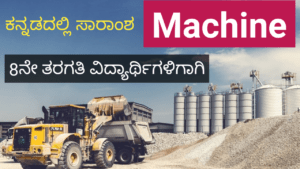
Machine poem summary for 8th standard students. We explained summary of the poem Machine in Kannada and English.
To get more video notes for class 8th visit our YouTube channel. This channel is very useful for 8th standard exam preparation.
About the poet:
Rudyard Kipling [1865-1936] is an Indian born British novelist, short-story writer, and poet. He was brought up in England, but came back to India and worked as a journalist.
His famous works are:
Barrack – Room Ballads, Kim, Captain Courageous. His books “Just 50 stories” and “Puck of Pook’s Hill” are very popular. He was awarded the Nobel Prize for Literature in 1907.
Glossary:
ore-bed: ಅದಿರು
Mine: ಗಣಿಗಾರಿಕೆ
Melted: ಕರಗಿದೆ
Furnace: ಕುಲುಮೆ
Pit: ಹೊಂಡ
Cast: ರೂಪ
Wrought: ಸುತ್ತಿಗೆಯಿಂದ ತಟ್ಟಿದ
Hammered: ಬಡಿಯಲಾಗಿದೆ
Filed: ರಾಶಿ ಹಾಕು
Gauged: ಅಳೆಯಲಾಗಿದೆ
Coal: ಕಲ್ಲಿದ್ದಲು
Pull: ಎಳೆಯಿರಿ
Push: ತಳ್ಳು
Plough: ಉಳುಮೆ
Weave: ನೇಯ್ಗೆ
Dive: ಧುಮುಕು
Law: ಕಾನೂನು
Comprehend: ಗ್ರಹಿಸು
Lie: ಸುಳ್ಳು
Pity: ಕರುಣೆ
slip: ಹಿಡಿತಕ್ಕೆ ಸಿಗದ, ಜಾರು
Handling: ನಿರ್ವಹಣೆ
Smoke: ಹೊಗೆ
Hide: ಮುಚ್ಚಿಡು
Heaven: ಸ್ವರ್ಗ
Vanish: ಕಣ್ಮರೆಯಾಗಿಸು
Summary in Kannada:
‘Machine’ ಎಂಬುದು ರುಡ್ಯಾರ್ಡ್ ಕಿಪ್ಲಿಂಗ್ ಅವರು ಬರೆದ ಕವಿತೆಯಾಗಿದೆ. ಈ ಕವಿತೆ ಆಧುನಿಕ ತಂತ್ರಜ್ಞಾನ ಮತ್ತು ಯಂತ್ರಗಳ ಸಮಸ್ಯೆಯನ್ನು ವ್ಯವಹರಿಸುತ್ತದೆ. ಮೊದಲ ಚರಣದಲ್ಲಿ. ಯಂತ್ರಗಳನ್ನು ಹೇಗೆ ಉತ್ಪಾದಿಸಲಾಗುತ್ತದೆ ಎಂದು ನಾವು ತಿಳಿದುಕೊಳ್ಳುತ್ತೇವೆ. ಆರಂಭದಲ್ಲಿ ಖನಿಜ ಅದಿರನ್ನು ಭೂಮಿಯಿಂದ ಅಗೆಯಲಾಗುತ್ತದೆ. ನಂತರ ಅದನ್ನು ಕುಲುಮೆಯಲ್ಲಿ ಕರಗಿಸಲಾಗುತ್ತದೆ. ಅದನ್ನು ಸುತ್ತಿಗೆಯಿಂದ ಅಚ್ಚು ಮಾಡಿ ಬೇಕಾದ ಆಕಾರಕ್ಕೆ ತರಲಾಗುತ್ತದೆ. ಇದನ್ನು ಅಳೆಯಲಾಗುತ್ತದೆ, ಕತ್ತರಿಸಲಾಗುತ್ತದೆ ಮತ್ತು ಸಲ್ಲಿಸಲಾಗುತ್ತದೆ ಮತ್ತು ಯಂತ್ರದ ರೂಪಕ್ಕೆ ತಯಾರಿಸಲಾಗುತ್ತದೆ. ವಿವಿಧ ಕಾರ್ಯಗಳನ್ನು ನಿರ್ವಹಿಸುವ ವಿವಿಧ ರೀತಿಯ ಯಂತ್ರಗಳಿವೆ.
ಎರಡನೆಯ ಚರಣದಲ್ಲಿ, ಯಂತ್ರವು ಕೆಲಸವನ್ನು ಮಾಡಲು ನೀರು, ಕಲ್ಲಿದ್ದಲು ಮತ್ತು ಎಣ್ಣೆ ಬೇಕು ಎಂದು ನಾವು ತಿಳಿದುಕೊಂಡಿದ್ದೇವೆ. ಯಂತ್ರಗಳು ಒಮ್ಮೆ ಕೆಲಸ ಮಾಡಲು ಹೊಂದಿಸಿದರೆ, ಅದು ಇಡೀ ದಿನ ಕೆಲಸ ಮಾಡುತ್ತದೆ. ಯಂತ್ರಗಳು ಅದಕ್ಕೆ ನಿಯೋಜಿಸಲಾದ ಕೆಲಸ ಏನೇ ಇರಲಿ, ಕೆಲಸವನ್ನು ಸರಿಯಾಗಿ ಮಾಡಬಹುದು.
ಮೂರನೆಯ ಚರಣದಲ್ಲಿ ಯಂತ್ರಗಳು ಯಾವ ಕೆಲಸಗಳನ್ನು ಮಾಡುತ್ತವೆ ಎಂಬುದನ್ನು ಕಲಿಯುತ್ತೇವೆ. ಇದು ಎಳೆಯಬಹುದು ಮತ್ತು ತಳ್ಳಬಹುದು, ಎತ್ತಬಹುದು ಮತ್ತು ಓಡಿಸಬಹುದು. ಇದು ಮುದ್ರಣ, ನೇಗಿಲು, ನೇಯ್ಗೆ ಮತ್ತು ಶಾಖ ಮತ್ತು ಬೆಳಕನ್ನು ಉತ್ಪಾದಿಸುತ್ತದೆ. ಯಂತ್ರವು ಎಲ್ಲಾ ರೀತಿಯ ಕೆಲಸಗಳನ್ನು ಮಾಡಬಹುದು.
ನಾಲ್ಕನೇ ಚರಣದಲ್ಲಿ ನಾವು ಯಂತ್ರಗಳ ಸ್ವರೂಪವನ್ನು ಕಲಿಯುತ್ತೇವೆ. ಯಂತ್ರವು ಅರ್ಥಮಾಡಿಕೊಳ್ಳುವುದಿಲ್ಲ, ಅದು ಸುಳ್ಳನ್ನು ಹೇಳುವುದಿಲ್ಲ. ಅದು ಪ್ರೀತಿ ಅಥವಾ ಕರುಣೆ ಮತ್ತು ಕ್ಷಮಿಸಲು ಸಾಧ್ಯವಿಲ್ಲ. ಮನುಷ್ಯನು ಯಂತ್ರಗಳನ್ನು ಎಚ್ಚರಿಕೆಯಿಂದ ನಿರ್ವಹಿಸಬೇಕು ಇಲ್ಲದಿದ್ದರೆ ಅವನಿಗೆ ಹಾನಿ ಅಥವಾ ಸಾವು. ಯಂತ್ರಗಳನ್ನು ಸರಿಯಾದ ರೀತಿಯಲ್ಲಿ ಬಳಸದಿದ್ದರೆ ದೊಡ್ಡ ಅನಾಹುತಗಳಿಗೆ ಕಾರಣವಾಗಬಹುದು.
ಐದನೇ ಚರಣದಲ್ಲಿ ನಾವು ಯಂತ್ರದಿಂದ ಬರುವ ಹೊಗೆ ಆಕಾಶವನ್ನು ಆವರಿಸಬಹುದು ಮತ್ತು ಸ್ವರ್ಗದಲ್ಲಿ ದೇವರನ್ನು ಮರೆಮಾಡಬಹುದು ಎಂದು ನಾವು ಕಲಿಯುತ್ತೇವೆ. ಸ್ವಲ್ಪ ಸಮಯದ ನಂತರ, ಅದು ಕಣ್ಮರೆಯಾಗುತ್ತದೆ ಮತ್ತು ನಾವು ಮತ್ತೆ ನಕ್ಷತ್ರಗಳನ್ನು ನೋಡಬಹುದು. ಯಂತ್ರಗಳು ಗಾತ್ರದಲ್ಲಿ ದೊಡ್ಡದಾಗಿರುತ್ತವೆ, ಶಕ್ತಿಯುತವಾಗಿರುತ್ತವೆ ಮತ್ತು ಭಾರವಾಗಿರುತ್ತವೆ ಆದರೆ ನಿರ್ಜೀವವಾಗಿರುತ್ತವೆ ಮತ್ತು ಮನುಷ್ಯನಿಂದ ಮಾತ್ರ ಕಾರ್ಯನಿರ್ವಹಿಸುತ್ತವೆ. ಅದು ಮನುಷ್ಯನಿಲ್ಲದೆ ಏನನ್ನೂ ಮಾಡಲು ಸಾಧ್ಯವಿಲ್ಲ. ಇದನ್ನು ಮನುಷ್ಯನು ಸಹ ಕಂಡುಹಿಡಿದನು.
ಯಂತ್ರಗಳು ಮಹಾನ್ ಕಾರ್ಯಗಳಿಗೆ ಸಮರ್ಥವಾಗಿದ್ದರೂ, ಇನ್ನೂ ಮಾನವ ಮೆದುಳಿನ ಸೃಷ್ಟಿಗಿಂತ ಹೆಚ್ಚೇನೂ ಅಲ್ಲ ಎಂಬ ಹೇಳಿಕೆಯೊಂದಿಗೆ ಕವಿತೆ ಕೊನೆಗೊಳ್ಳುತ್ತದೆ.
Summary in English:
‘Machine’ Is a poem written by Rudyard Kipling. This Poem deals with the problem of modern technology and machines. In the first stanza. We come to know how machines are produced. Initially mineral ore is dug out from the earth. Then it is melted in the furnace. It is moulded and brought to the required shape by hammer. It is measured, cut and filed and made in to the machine. There are various types of machines which can do various tasks.
In the second stanza we came to know that to do the task it needs water, coal and oil. Once the machines are set to work, it will do the work whole day. Machines can do the work correctly, whatever may be the work assigned to it.
In the third stanza we learn what works will machines do. It can pull and push, lift and drive. It can also print, plough, weave and produce heat and light. Machine can do all the types of work.
In the fourth stanza we learn the nature of machines. Machine cannot understand, it cannot tell a lie. It can neither love nor pity and forgive. Man should handle the machines carefully otherwise he is harmed or death. Machines are not only useful but they can also lead to big disasters if they are not used in a right way.
In the fifth stanza we learn the smoke coming from the machine may cover the sky and hide the God in the heaven. After some time, it will disappear and we could see the stars again. The machines are big in size, powerful and heavy but lifeless, and operated by man only. It can’t do anything without man. It is also invented by man.
The poem ends with the statement that machines, although capable of great deeds, are still nothing more than creations of the human brain.
Watch this video for explanation of Machine poem summary in Kannada and English for 8th class students.